
My Report Projects
My report projects that covers risk management topics and fintech development.
Fintech Innovation Report
Fintech innvovation was a very interesting module that allowed me to learn about the different types of banks available (Retail banking, Private banking, Corporate banking etc.) as well as the products that are available for the consumers.
The module also covered fintech innovations that has disrupted the financial scene and how it proves to be more efficient and useful than central digital bank services and system.
The project required me to choose a banking sector and find a fintech development that has relevance to that banking sector and research on the services and products they offer and how are they different from the bank as well as identifying digital bank's pain point. This allowed me to explore different fintech developments and for my project I chose to write about the corporate banking sector and picked October.eu as the fintech company to research on.
The overview covers the the summary of what October does and their overall business model. The next part covers what problems lie in the digital central banking system and services and also why October.eu products and services is a solution to it.
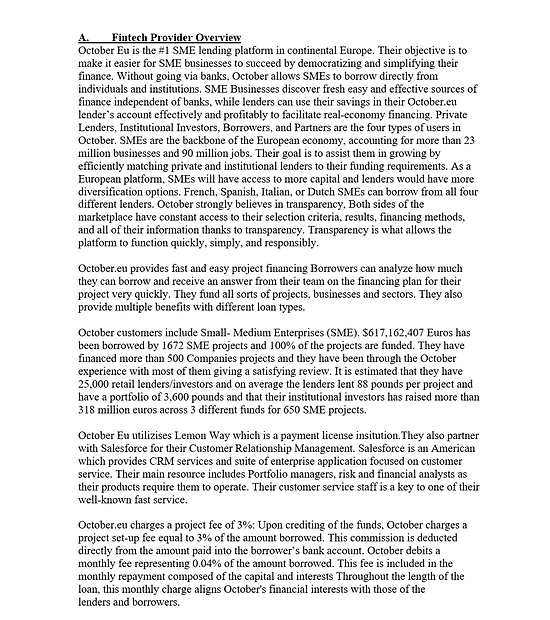
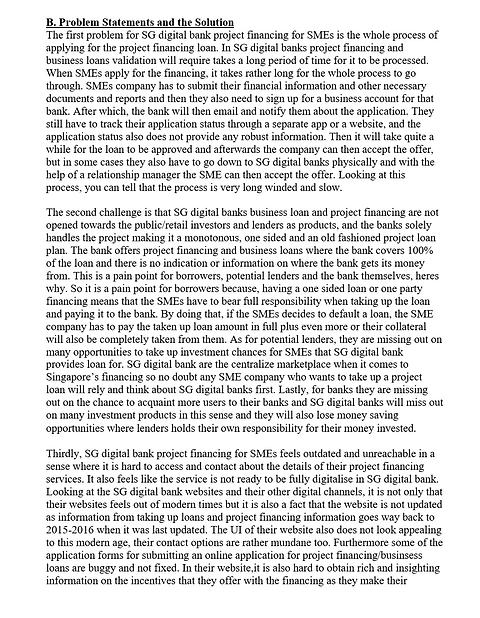
The third part of the report describes the benefits that this solution brings if it is implemented to the central digital bank systems. The benefits include: Reducing money lost, enhance speed of corporate financing being procesed, enhancing the bank's asset portfolio and increases convenience for both clients and workers
The fourth part discusses about the risk to implement such a solution such as cost, transitioning from their legacy systems, legal issues, transparency, inbalance in the banks products etc.
Lastly, it is the conclusion to wrap up the summary of the report and I even included my personal experience when researching October.eu like trying out their excellent customer service support which is part of the solution to digital bank's pain points.


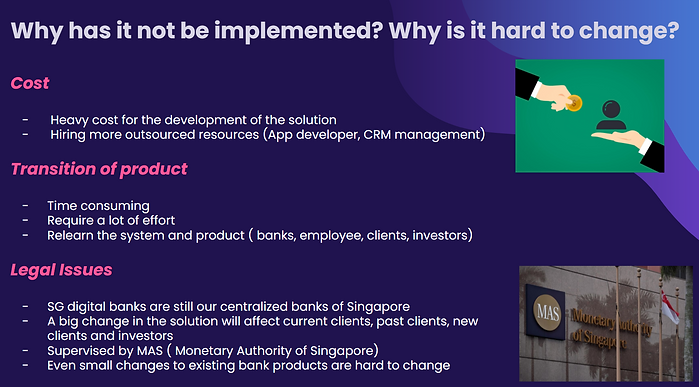

Risk & Governance
The module risk and governance covers risk management topics as well as getting to know diving into case studies of financial fraud & financial crisis, enriching our knowledge of the history of financial incidents and learning how each type of risk is applied in these cases.
The first project is a group project where teams are given different case studies to work on and we are required to create a presentation on the case study that we get within a week.
The presentation included the overview of the case study and what caused the financial fraud or incident. It also mentioned who was involved in the case and what risk types were involved. The presentation also highlights what we as a team learn from this case study. Our lecturer told us that this project was meant to be more casual and fun so that everyone can understand the case study and take away something at the end of the day.
My team's case study was on the Lehman Brothers.
 |  |  |  |  |
|---|---|---|---|---|
 |
For this project I was in charge of identifying the risks type involved,
Through thorough research and reading up on the whole 2007 case, I managed to identify 8 different risks that was involved in the Lehman Brothers collapse.
Risks:
Operational Risk - The way they were operating was way too risky to be termed as a bank. The amount of greed and overconfidence that the housing market will never crash cause the fall in them
Compliance Risk - Technically not involved as for this case it was not considered a fraud but the subprime mortgages was a caustic asset that they held. Secondly, The Repo105 was not an accounting fraud but just a loophole in the accounting system but has since been regulated
Credit Risk & Interest Rate Risk - The whole mortgage backed securities that Lehman depended on borrowers to repay the loan for which the borrowers couldn’t pay the sub prime mortgages due to unforeseen circumstances. The unforseen circumstances refers to interest rate of the loans rising by 5.25%, and for that reason borrowers were not able to repay the loans, especially the subprime mortgage loans.
Liquidity & Price Risk - Although in their balance sheet they had more assets than liabilities, to be exact it was like 639 billion assets to 602 billion liabilities, but it didn’t mean anything. The assets they were holding meant nothing as a lot of the assets were the sub-prime mortgage loans where people defaulted the loans at a rapid rate, mortgage-backed securities and even real estate that they invested themselves, for which all these assets devalued. In the end, they only had an average of 7 billion in liquid assets while they had an underlying liability of 602 billion.
Strategic Risk - . They were too dependent on the value at risk model (VAR). For which this strategy does not identify the extent of the worst possible outcome.
Reputation Risk - The federal reserve decided not to bail them out as they used the Repo105 and their over leveraged strategy which affected their reputation. This strategy led to their downfall to their company's reputation, which led to rapid decrease in clients and workers losing their job.
Interest Rate Risk Report
This report was a project from the same module of risk and governance. In the same presenting team as mentioned above, we were given a scenario of a new developing bank in Singapore and we were tasked to find out about what risks will lie on their products and services . There were 5 different kinds of risk that we can choose from,
-
Credit Risk (Individual Customers)
-
Credit Risk (Corporate Customers)
-
Operational Risk (Non-technical)
-
Operational Risk (Technical)
-
Liquidity Risk
-
Market Risk (Interest Rate)
I chose market risk (interest rate) to write my report on as I found this topic rather interesting and that by doing this project I will be able to understand how interest rate was derived and why it will affect me personally.
There were some key points that we had to cover in this project:
-
Based on products/services, discuss sources of risks that the new bank will face
-
Mention 1 to 2 risk measurement methods and how it can be applied to this scenario
-
Mention 1 to 2 risk mitigation methods and how it can be applied to this scenario
-
Disucss anything related to interest rate risk (free writing)
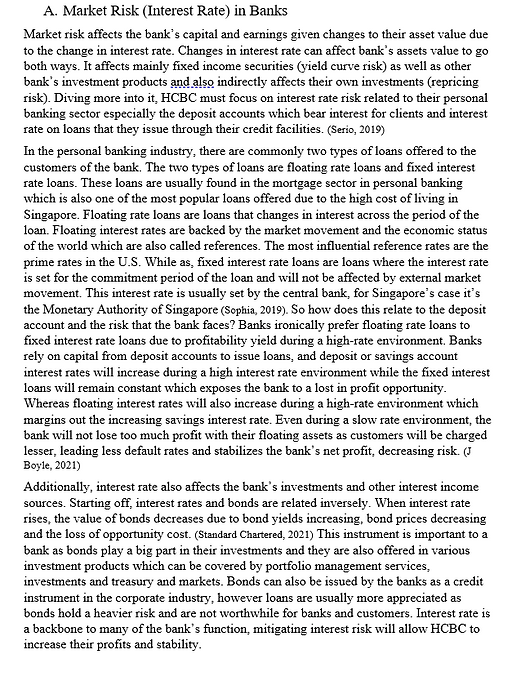
For the first page of the report, i mention about the overview of the risk type and how it will affect the bank vaguely. The second paragraph talks about how loans are affected by interest rate rise and drops. I also discussed the different types of loans in the bank and how it will get affected,
- Floating rate loans
- Fixed rate loans
I also talked about the relation between loans and savings account and the effects of different interest rate environment to these 2 bank products and why is it risky to the bank
The third paragraph talks about the bank's investments and other interest income sources such as bonds and how bonds will be affected by a change in interest rate. Although this is not a product but it poses risk to the bank's sources of profit.
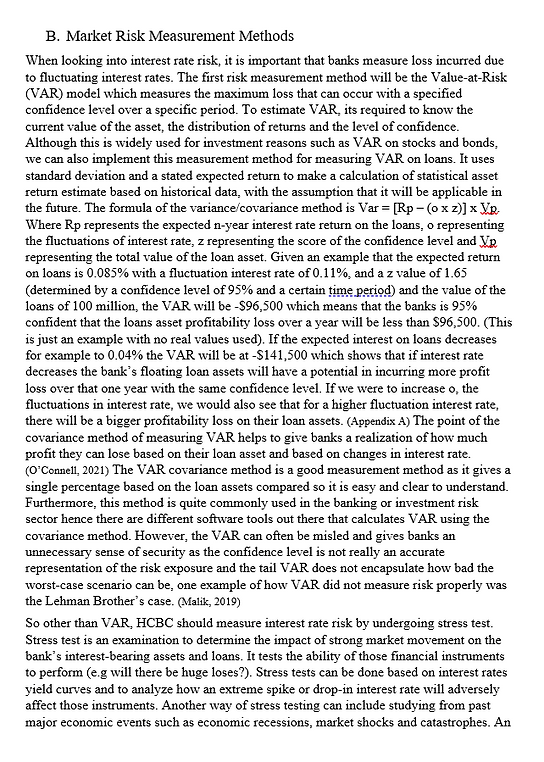
The second page of the report mentions about risk measurement methods. I chose to talk about Value At Risk (VAR) Covariance measurement method on loans (main product). In the first paragraph I gave a brief description of how VAR works and how to measure it. I also mention that although VAR is usually meant for measuring risk in investment products like stocks it could still be related to loans. I then gave an example of how the variance/covariance measurement method is calculated and what it shows. I also stated the advantages and disadvantages of using this method to measure interest rate risk.
The second measurement method was stress testing, where i gave an overview about it and also gave an example of how stress testing can be used.
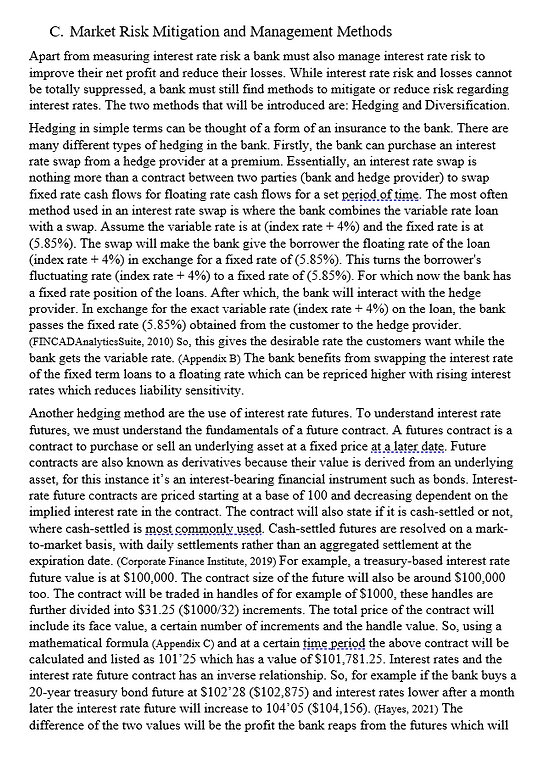
The third page of the report mentions about risk mitigation methods. The two mitigation methods were Hedging and Diversification.
For Hedging, I suggested using interest rate swaps and interest rate futures. For both hedging methods, I gave a synopsis of the use of the two instruments and gave an example for each method and the benefit the bank yields from using these methods.
For Diversification, I mentioned about how banks can diversify the different types of loans they hold (different types of floating rate loans, fixed rate loans , loan type etc.), I also talked about how the bank could hold different types of bonds in their portfolio (AA credit grade bonds etc.) and what benefits it brings to the bank for using the diversification method.
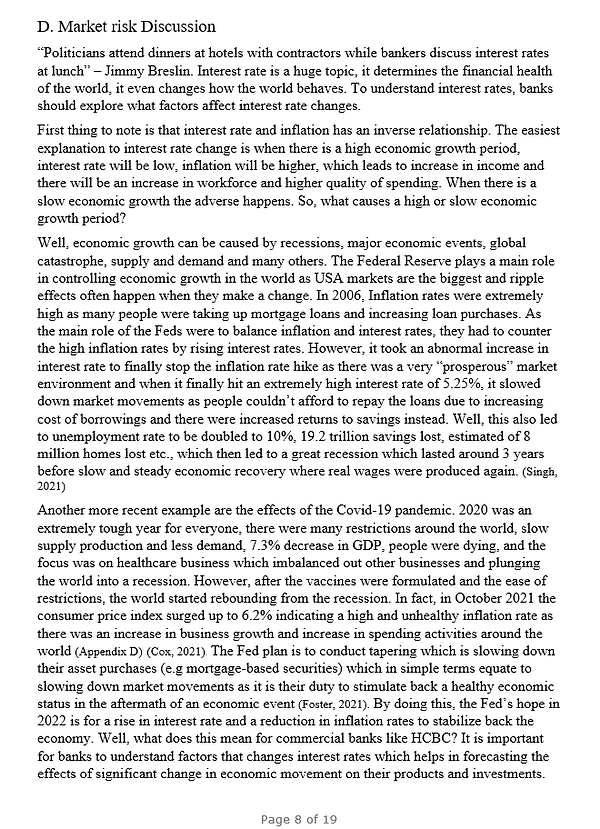
For the fourth page, as it was a page for open discussion on interest rate risk, I decided to to discuss about what affects the rise and drop in interest rate. I briefly mention about how inflation has an adverse relationship with interest rate and how inflation is the main reason why interest rate rises or drops. I then explained more about inflation and cited the 2007 financial crisis and how interest rate and inflation played a major role in it.
Next, I discuss about a more relevant issue which is the Covid-19 pandemic and how when the economy started to climb back in Q3 2021 it spiked inflation and how it is affecting everyone. It also mentions about how the federal reserve in USA is trying to mitigate the unhealthy inflation level and to sum it all, I concluded with how new banks can be affected by market movements like these examples and that assessing and acting on different situations can be advantageous to them but not reacting to it can cause losses.
To view the full report, please contact me.